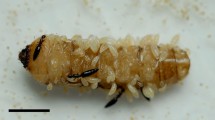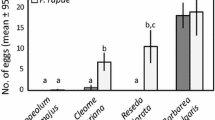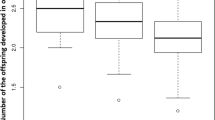Abstract
In behavioral ecology it is generally assumed that behavior is adaptive. This assumption is tested here for sex ratio manipulation in response to host size in the parasitoid wasp Spalangia cameroni. Females produce a greater proportion of daughters on larger hosts. If this behavior is adaptive, it is not through a positive effect of host size on the fitness of daughters, as theory suggests and as found for other species. Females that developed on larger hosts were not more successful at drilling into hosts, were not more successful at interspecific competition for hosts, and did not have greater dispersal ability as measured by wing loading (weight/area of wing and thorax). The possibility that S. cameroni's sex ratio manipulation may be adaptive through a negative effect of host size on the fitness of sons cannot be ruled out. Relative to males from larger hosts, males from smaller hosts had lower wing loading and thus potentially greater dispersal ability. The actual effect of wing loading on fitness remains to be tested.
Similar content being viewed by others
References
Assem J van den, Iersel JJA van, Los-den Hartogh RL (1989) Is being large more important for female than for male parasitic wasps? Behaviour 108:160–195
Austad SN, Sunquist ME (1986) Sex-ratio manipulation in the common opossum. Nature 324:58–60
Charnov EL (1979) The genetical evolution of patterns of sexuality: Darwinian fitness. Am Nat 113:465–480
Charnov EL (1982) The theory of sex allocation. Princeton University Press, Princeton, NJ
Charnov EL, Los-den Hartogh RL, Jones WT, Assem J van den (1981) Sex ratio evolution in a variable environment. Nature 289:27–33
Donaldson JS, Walter GH (1984) Sex ratios of Spalangia endius (Hymenoptera: Pteromalidae), in relation to current theory. Ecol Entomol 9:395–402
Epting RJ, Casey TM (1973) Power output and wing disc loading in hovering hummingbirds. Am Nat 107:761–765
Garcia-Saez C (1988) Sex ratio and fitness in a parasitic wasp. PhD dissertation, University of London
Gauld I, Bolton B (1988) The Hymenoptera. Oxford University Press, New York
Gerling D, Legner EF (1968) Developmental history and reproduction of Spalangia cameroni, parasite of synanthropic flies. Ann Entomol Soc Am 61:1436–1443
Heinz KM (1991) Sex-specific reproductive consequences of body size in the solitary ectoparasitoid Diglyphus begini. Evolution 45: 1511–1515
Holdaway FT, Smith HF (1932) A relation between size of host puparia and sex ratio of Alysiamanducator. Aust J Exp Biol Med Sci 10: 247–259
Hurlbutt BL (1987) Sex ratio in a parasitoid wasp Spalangia cameroni (Hymenoptera: Pteromalidae). PhD dissertation. Purdue University, West Lafayette, IN.
Jones WT (1982) Sex ratio and host size in a parasitoid wasp. Behav Ecol Sociobiol 10: 207–210
Kammer AE, Heinrich B (1978) Insect flight metabolism. Adv. Insect Physiol. 13: 133–228
King BH (1987) Offspring sex ratios in parasitoid wasps. Q Rev Biol 62: 367–396
King BH (1988) Sex-ratio manipulation in response to host size by the parasitoid wasp Spalangia cameroni: a laboratory study. Evolution 42: 1190–1198
King BH (1991a) A field study of host size effects on sex ratio of the parasitoid wasp Spalangia cameroni. Am Midl Nat 25: 10–17
King BH (1991b) No intersexual differences in host size and species usage in Spalangia endius (Hymenoptera: Pteromalidae). Great Lakes Entomol 24: 17–20
King BH (1993) Sex ratio manipulation by parasitoid wasps. In: Wrensch DL, Ebbert M (eds) Evolution and diversity of sex ratio in insects and mites. Chapman and Hall, New York, pp 418–441
King BH (1994) How do female parasitoid wasps assess host size during sex-ratio manipulation? Animal Behaviour 48: 511–518
King BH, King RB (1994) Sex ratio manipulation in response to host size in the parasitoid wasp Spalangia cameroni: is it adaptive? Behavioral Ecology 5 : (in press)
Krebs JR, Davies NB (1987) An introduction to behavioral ecology, 2nd ed. Blackwell Scientific, Oxford
Meyer JA, Schultz TA, Collar C, Mullens BA (1991) Relative abundance of stable fly and house fly (Diptera: Muscidae) pupal parasites (Hymenoptera: Pteromalidae; Coleoptera: Staphylinidae) on confinement dairies in California. Environ Entomol 20: 915–921
Mullens BA, Meyer JA, Mandeville JD (1986) Seasonal and diel activity of filth fly (Musca domestica) parasites (Hymenoptera: Pteromalidae) in caged-layer poultry manure in southern California. Environ Entomol 15: 56–60
Paul A, Kuester J (1990) Adaptive significance of sex ratio adjustment in semifree-ranging Barbary macaques (Macaca sylvanus) at Salem. Behav Ecol Sociobiol 27: 287–293
Propp GD, Morgan PB (1985) Effect of host distribution on parasitoidism of house-fly (Diptera: Muscidae) pupae by Spalangia spp. and Muscidifurax raptor (Hymenoptera: Pteromalidae). Can Entomol 117: 515–524
Rueda LM, Axtell RC (1985) Guide to common species of pupal parasites (Hymenoptera: Pteromalidae) of the house fly and other muscoid flies associated with poultry and livestock manure. (Technical Bulletin 278). North Carolina Agricultural Research Service, North Carolina State University
Ruohomäki K (1992) Wing size variation in Epirrita autumnata (Lep., Geometridae) in relation to larval density. Oikos 63: 260–266
Seidl SE, King BH (1993). Sex ratio response to host size in the parasitoid wasp Muscidifurax raptor. Evolution 47: 1876–1882
Shaw RG, Mitchell-Olds T (1993) ANOVA for unbalanced data: an overview. Ecology 74: 1638–1645
Southwood THE (1988) Tactics, strategies and templets. Oikos 52: 3–18
Starmer WT, Wolf LL (1989) Causes of variation in wing loading among Drosophila species. Biol J Linn Soc 37: 247–261
Werren JH (1980) Sex ratio adaptations to local mate competition in a parasitic wasp. Science 208: 1157–1159
Werren JH (1983) Sex ratio evolution under local mate competition in a parasitic wasp. Evolution 37: 116–124
Author information
Authors and Affiliations
Additional information
Communicated by R.H. Crozier
Rights and permissions
About this article
Cite this article
King, B.H., Lee, H.E. Test of the adaptiveness of sex ratio manipulation in a parasitoid wasp. Behav Ecol Sociobiol 35, 437–443 (1994). https://doi.org/10.1007/BF00165847
Received:
Accepted:
Issue Date:
DOI: https://doi.org/10.1007/BF00165847




